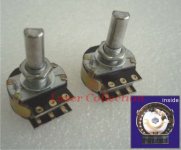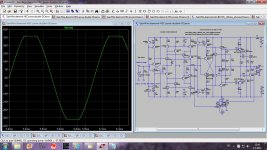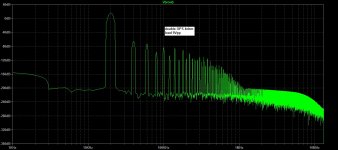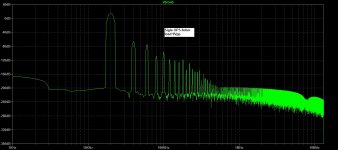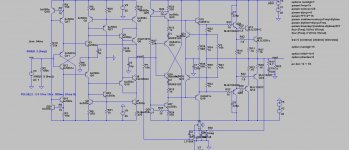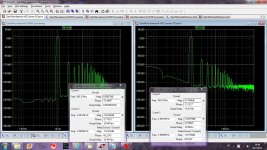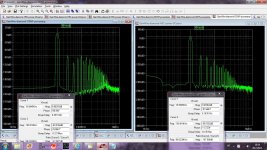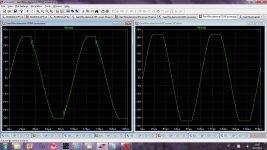Only thing I can add is that it is worth considering adding a low pass filter to the servo output. Another defence against high frequency nasties getting through the servo.
This servo is low pass filter.
This servo is low pass filter.
But does not block very high frequencies. They can still get through. Look at sallen key (I think that's the right type) filters. At high enough frequencies they start to pass the signal again.
Its only two extra components, split the 10k in to two 5ks and add a cap to ground from the middle.
Last edited:
Its only two extra components, split the 10k in to two 5ks and add a cap to ground from the middle.
+1...I would do the same for servo input...filter any noise on the amplifier output
But does not block very high frequencies. They can still get through. Look at sallen key (I think that's the right type) filters. At high enough frequencies they start to pass the signal again.
Its only two extra components, split the 10k in to two 5ks and add a cap to ground from the middle.
What 10k resistor you are tallking about? If you mean P1 that is volume control and can't be split.
What 10k resistor you are tallking about? If you mean P1 that is volume control and can't be split.
P1 looks like the output of the DC servo. I may be being a little stupid but I'm not following how this is the volume control. With the distortion feedback I could see how it was the a gain control but this is a DC servo. Please could you explain the function of P1 to someone lacking in understanding.
P1 looks like the output of the DC servo. I may be being a little stupid but I'm not following how this is the volume control. With the distortion feedback I could see how it was the a gain control but this is a DC servo. Please could you explain the function of P1 to someone lacking in understanding.
Without DC servo P1 is connected to the ground and ratio of P1/R9 define the gain of the gain stage(current conveyor). So to maintain that when DC servo is connected it's important that servo opamp has low output impedance to play as the ground.
Thank you, for the explanation.
Would you be kind enough to post an .asc file of this? Looks interesting and I'd like to understand its function better.
You can simulate with different P1 values, 10k is max, and you'll see haw the gain changes.
If you connect P1 to the ground instead to the DC servo output, DC servo will be off.
Attachments
You can simulate with different P1 values, 10k is max, and you'll see haw the gain changes.
If you connect P1 to the ground instead to the DC servo output, DC servo will be off.
Thank you, this will be interesting!
Thank you, this will be interesting!
How did go your simulation?
I have a mod for you to try add a resistor between v(out) and the junction of R34 and R35. I've just tried a random value of 10R. Got a decent distortion reduction. See if you get the same.
Yes it decreases distortion at 1kHz but increases at 20kHz.
Yes, you are right.
One thing that may be worth looking at, is getting this amp to drive 4R loads better. It seems to struggle with this (I know HECs don't like low impedance loads). Don't know what you plan to drive with this amp. 8R speakers (as you know) will have lower impedance at some frequencies and it would be good not to get such an increase in THD.
Otherwise, looking good in sims.
One thing that may be worth looking at, is getting this amp to drive 4R loads better. It seems to struggle with this (I know HECs don't like low impedance loads). Don't know what you plan to drive with this amp. 8R speakers (as you know) will have lower impedance at some frequencies and it would be good not to get such an increase in THD.

Otherwise, looking good in sims.
Yes, you are right.
One thing that may be worth looking at, is getting this amp to drive 4R loads better. It seems to struggle with this (I know HECs don't like low impedance loads). Don't know what you plan to drive with this amp. 8R speakers (as you know) will have lower impedance at some frequencies and it would be good not to get such an increase in THD.
Otherwise, looking good in sims.
OPS with double output pair could drive 4ohm load with not to mutch distotion increase.
Simulation shows THD20k with 8ohm load and output swing of 9Vpp 0.008458% to increase s to 0.009697% at 4ohm load.
Attached are:
schematic
FFTs
Clipping
Off course this is still open for improvement and suggestion.
BR Damir
Attachments
ODNF vs HEC
I will try to compare ODNF type of the power amp with the one with HEC output stage.
ODNF looks very promising but after extensive simulation my opinion is that it has some disadvantage compared with NGNFB with HEC output stage.
At first glance ODNF offers lower distortion, but first it’s tricky to adjust voltage divider at –IN of the opamp for lowest distortion. Attenuation of that divider should be the same as the gain of whole amp, but in practice it differs influenced by used opamp for ODNF feedback. And more it changes with input signal level, at least in the simulation. If we look at distortion harmonics distribution HEC looks much better.
Finally the clipping behavior of HEC is better the the one of ODNF.
Damir
I will try to compare ODNF type of the power amp with the one with HEC output stage.
ODNF looks very promising but after extensive simulation my opinion is that it has some disadvantage compared with NGNFB with HEC output stage.
At first glance ODNF offers lower distortion, but first it’s tricky to adjust voltage divider at –IN of the opamp for lowest distortion. Attenuation of that divider should be the same as the gain of whole amp, but in practice it differs influenced by used opamp for ODNF feedback. And more it changes with input signal level, at least in the simulation. If we look at distortion harmonics distribution HEC looks much better.
Finally the clipping behavior of HEC is better the the one of ODNF.
Damir
Attachments
Damir can you provide asc file with the ODNF circuit. Could you find the cause for the clipping behavior ??
I think the cause is in the opamp, it can't cope at the higher frequences, at 1kHz it's OK.
Attachments
Thanks. Perhaps, the difficulty lies in that the models for opamps are terrible, even worse than one finds for other devices. I was looking at achieving below .01 THD20 figures but at 100 w RMS power. It must be possible as Luxman obtain this at even higher power and quite frankly their inputstage is not as good as yours.
Thanks. Perhaps, the difficulty lies in that the models for opamps are terrible, even worse than one finds for other devices. I was looking at achieving below .01 THD20 figures but at 100 w RMS power. It must be possible as Luxman obtain this at even higher power and quite frankly their inputstage is not as good as yours.
I am trying to use PSpice model for LME49710 provided by TI but with no success.
- Status
- This old topic is closed. If you want to reopen this topic, contact a moderator using the "Report Post" button.
- Home
- Amplifiers
- Solid State
- ODNF or no GNFB power amp
